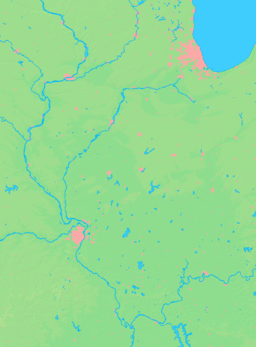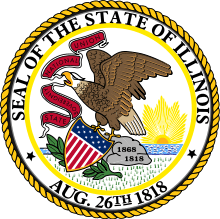Freeburg, Illinois
| Freeburg | |
| Village | |
| Country | United States |
|---|---|
| State | Illinois |
| County | St. Clair |
| Coordinates | 38°25′37″N 89°54′38″W / 38.42694°N 89.91056°WCoordinates: 38°25′37″N 89°54′38″W / 38.42694°N 89.91056°W |
| Area | 7.03 sq mi (18 km2) |
| - land | 6.77 sq mi (18 km2) |
| - water | 0.26 sq mi (1 km2) |
| Population | 4,354 (2010) |
| Density | 1,215.1/sq mi (469/km2) |
| Timezone | CST (UTC-6) |
| - summer (DST) | CDT (UTC-5) |
| Postal code | 62243 |
| Area code | 618 |
  Location of Freeburg within Illinois | |
| Wikimedia Commons: Freeburg, Illinois | |
| Website: http://www.freeburg.com | |

Freeburg is a village in St. Clair County, Illinois, United States. As of 2010, Freeburg had a population of 4,354. Seth Speiser is the mayor of Freeburg
History
Freeburg lies in the fertile and rolling southern Illinois plains between the Kaskaskia and Mississippi Rivers. It was platted in 1836 as the town of Urbana by immigrants to this area from Virginia around 1800. The first European settlers of Freeburg were of English and Irish ancestry.
There were five migratory Indian tribes that crisscrossed each other in Illinois; the Peorias, Cahokias, Kaskaskias, Tamaroas, and Michiganics. It is said that Turkey Hill north of town was a popular Indian campground that also attracted many early settlers because of the view it provided of the surrounding countryside. The last Indian tribes left this area by 1820.
The big German migrations to this area started around 1830 and continued quite strong for the rest of the century. Obviously, the abundance of coal, the availability of cheap fertile farm land, as well as the proximity to the frontier city of St. Louis, only 20 miles to the northwest, are what attracted settlers to Freeburg.
The old "Plank Road" was built in the 1850s, and for 35 cents, travelers could ride from Belleville to Freeburg in "comfort" without potholes on what is now known as the old Freeburg Road. Abe Lincoln is said to have used this road on at least one occasion.
In 1851, the post office came, and when it was found that there was another town of Urbana in Illinois, the city fathers changed the name in 1859 to Freeburg after the beautiful city of Freiburg in the state of Baden, Germany, from which some of the early settlers had come.
The town was incorporated in 1867 with 808 residents. The railroad came in 1869 and exchanged owners several times before being sold to the Illinois Central.
In the heyday of independent coal mines, as many as 1500 miners lived here, and in 1874, there were 10 hotels for them to choose from if they could not find more permanent lodging. With the closing of the Peabody River King Mine just east of Freeburg in 1989, coal no longer played a dominant role in the local economy.
Today, Freeburg remains a conservative community with a highly diversified business economy that also serves as a bedroom community for Belleville and the St. Louis metroplex, while still providing essential services needed in any small community.
Geography
Freeburg is located at 38°25′37″N 89°54′38″W / 38.42694°N 89.91056°W (38.426949, -89.910451).[1]
According to the 2010 census, Freeburg has a total area of 7.025 square miles (18.19 km2), of which 6.77 square miles (17.53 km2) (or 96.37%) is land and 0.255 square miles (0.66 km2) (or 3.63%) is water.[2]
Freeburg has historically been a farming community, but as the nearby cities of Belleville and Fairview Heights have grown, parts of Freeburg have been developed with subdivisions that resemble a suburb.
Freeburg enjoys a low crime rate, particularly compared to the cities immediately to its north, and land values have attracted some commuters who live in Freeburg and work the short distance to St. Louis, Missouri.[3]
Demographics
| Historical population | |||
|---|---|---|---|
| Census | Pop. | %± | |
| 1860 | 560 | — | |
| 1870 | 920 | 64.3% | |
| 1880 | 1,038 | 12.8% | |
| 1890 | 848 | −18.3% | |
| 1900 | 1,214 | 43.2% | |
| 1910 | 1,397 | 15.1% | |
| 1920 | 1,594 | 14.1% | |
| 1930 | 1,434 | −10.0% | |
| 1940 | 1,507 | 5.1% | |
| 1950 | 1,661 | 10.2% | |
| 1960 | 1,908 | 14.9% | |
| 1970 | 2,495 | 30.8% | |
| 1980 | 2,989 | 19.8% | |
| 1990 | 3,115 | 4.2% | |
| 2000 | 3,872 | 24.3% | |
| 2010 | 4,354 | 12.4% | |
| Est. 2015 | 4,241 | [4] | −2.6% |
As of the census[6] of 2000, there were 3,872 people, 1,414 households, and 1,063 families residing in the village. The population density was 1,215.1 people per square mile (468.6/km²). There were 1,485 housing units at an average density of 466.0 per square mile (179.7/km²). The racial makeup of the village was 98.55% White, 0.15% African American, 0.28% Native American, 0.21% Asian, 0.10% Pacific Islander, 0.21% from other races, and 0.49% from two or more races. Hispanic or Latino of any race were 1.11% of the population.
There were 1,414 households out of which 39.2% had children under the age of 18 living with them, 60.1% were married couples living together, 11.7% had a female householder with no husband present, and 24.8% were non-families. 21.9% of all households were made up of individuals and 10.5% had someone living alone who was 65 years of age or older. The average household size was 2.65 and the average family size was 3.08.
In the village the population was spread out with 27.1% under the age of 18, 6.9% from 18 to 24, 29.3% from 25 to 44 22.0% from 45 to 64, and 14.6% who were 65 years of age or older. The median age was 38 years. For every 100 females there were 91.9 males. For every 100 females age 18 and over, there were 86.7 males.
The median income for a household in the village was $51,434 and the median income for a family was $57,632. Males had a median income of $37,857 versus $27,929 for females. The per capita income for the village was $19,851. About 6.1% of families and 5.7% of the population were below the poverty line, including 7.8% of those under age 18 and 3.9% of those age 65 or over.
Education
Notable people
- Dutch Hoffman, outfielder for the Chicago White Sox
- Danny Cox, former pitcher for the St. Louis Cardinals
In film
Jeanies, a now-demolished cafe on the northern outskirts of the town, was used for the filming of In the Heat of the Night.[7]
References
- ↑ "US Gazetteer files: 2010, 2000, and 1990". United States Census Bureau. 2011-02-12. Retrieved 2011-04-23.
- ↑ "G001 - Geographic Identifiers - 2010 Census Summary File 1". United States Census Bureau. Retrieved 2015-08-03.
- ↑ Freeburg, Illinois
- ↑ "Annual Estimates of the Resident Population for Incorporated Places: April 1, 2010 to July 1, 2015". Retrieved July 2, 2016.
- ↑ "Census of Population and Housing". Census.gov. Retrieved June 4, 2015.
- ↑ "American FactFinder". United States Census Bureau. Retrieved 2008-01-31.
- ↑ "IMDB In the Heat of the Night, Filming Locations".
